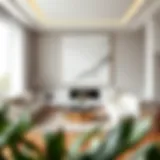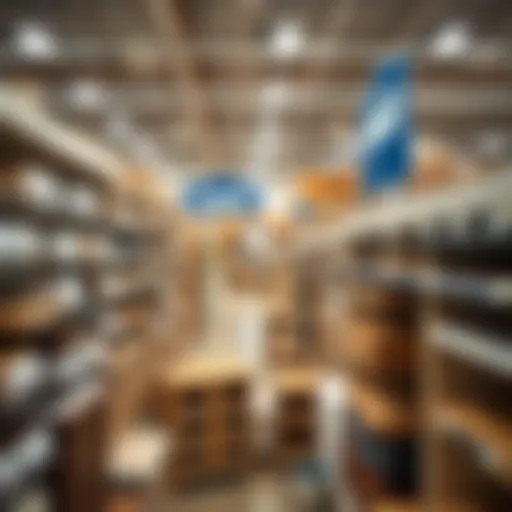Innovative Concepts for Shop Shelves Design and Functionality
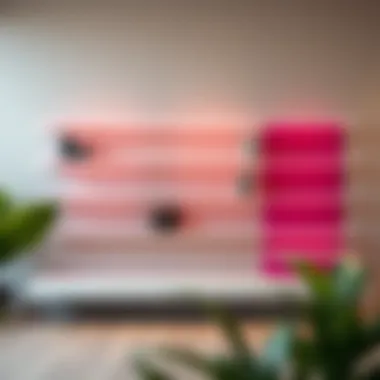
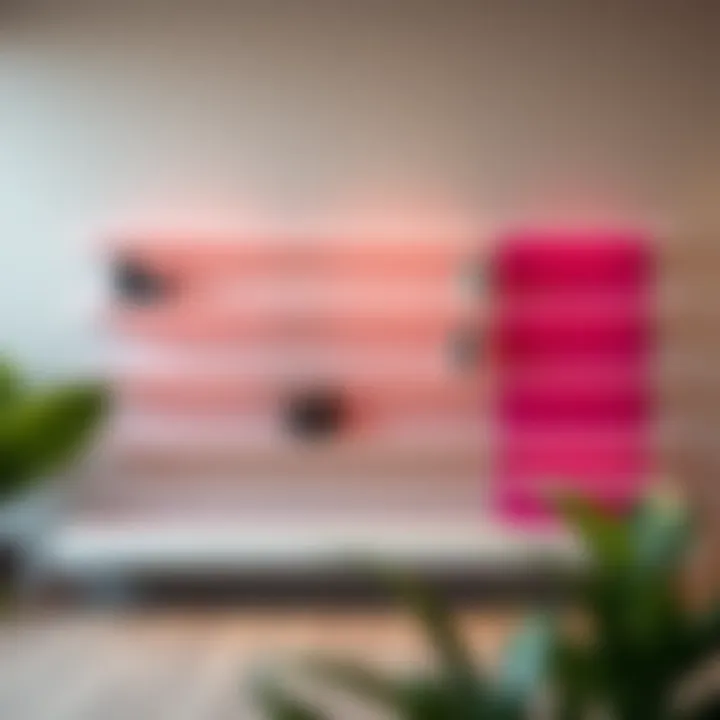
Intro
In today’s bustling retail environment, the way products are displayed can greatly influence customer experience and purchasing decisions. The concept of shop shelves is not just limited to mere storage; it's intricately tied to how consumers perceive and interact with the items offered. A thoughtfully designed shelf can transform a mundane shopping trip into an engaging journey, guiding customers through a carefully curated experience. This article explores imaginative shelving concepts that enhance both aesthetics and functionality, providing insights and strategies for retail spaces aiming to stand out in a crowded marketplace.
Furniture Trends and Styles
Current Trends in Furniture Design
The landscape of furniture design has seen significant evolution, reflecting broader societal shifts in consumer preferences and values. Currently, we observe a rise in sustainable materials, emphasizing eco-friendliness without sacrificing style. For instance, reclaimed wood is increasingly popular, offering a rustic charm while promoting sustainability. Additionally, minimalistic designs are becoming the norm, favoring clean lines and understated elegance that can seamlessly integrate into various retail settings.
Moreover, the attention to modularity has surged. Retailers are now drawn to shelving systems that can be easily reconfigured to adapt to seasonal changes or promotional displays. This flexibility ensures a dynamic shopping experience, preventing the layout from feeling stale over time.
Popular Furniture Styles and Their Characteristics
When it comes to shelves, several distinct styles have gained traction:
- Industrial Style: Characterized by raw materials like metal and unfinished wood, often seen in urban settings. This style injects a contemporary edge into the retail space while being highly durable.
- Scandinavian Design: Known for its simplicity and functionality, this style emphasizes light colors, natural materials, and accessibility, which resonates well with consumers seeking a calm shopping environment.
- Farmhouse Chic: This look combines vintage elements with a cozy feel, often incorporating distressed wood and neutral tones. It creates a welcoming atmosphere, encouraging customers to linger.
Each style brings a unique perspective to shelving, affecting not only how products are displayed but also how they are perceived by shoppers.
"Good design is about how it works, not just how it looks."
— Steve Jobs
Buying and Maintenance Guides
Essential Tips for Purchasing Furniture
When investing in shelving systems for retail spaces, consider the following:
- Assess the Space: Measure your area carefully to determine the size and scale of the shelves that will work best.
- Material Matters: Look for materials that align with the brand’s values; this includes considering sustainability and durability.
- Functionality is Key: Choose designs that enhance usability. Shelves should accommodate various products, from small items to bulky displays.
- Aesthetic Alignment: Ensure the shelving style matches the overall brand image. Consistency in design promotes stronger brand recognition.
Maintenance and Care for Different Furniture Materials
The longevity of retail shelving hinges on proper maintenance. Different materials require unique care:
- Wood: Regular dusting and occasional polishing with appropriate products help retain its luster. Avoid excess moisture to prevent warping.
- Metal: Wipe down with a damp cloth and dry immediately to prevent rust and discoloration.
- Glass: Use glass cleaner to keep surfaces spotless, ensuring visual clarity for displayed products.
By following these guidelines, retailers can enhance the aesthetics and functionality of their shop shelves, creating an inviting space that encourages exploration and purchase.
Understanding the Purpose of Shop Shelves
Understanding the purpose of shop shelves is pivotal in crafting a retail space that not only sells but also tells a story. Shelving units are not merely functional fixtures but can act as critical elements in creating an engaging shopping experience. The right shelves can highlight products, influence customer behavior, and enhance the overall aesthetic of the store. In this section, we will explore the functionality of store shelving and the psychological impact that shelf arrangements can have on shoppers.
Functionality of Store Shelving
When we talk about the functionality of store shelving, it’s essential to recognize several key aspects:
- Support and Capacity: First and foremost, shelves must be capable of holding weight. Depending on the products on display, the materials and design of the shelves should be chosen to ensure safety and stability. Heavy items require sturdier options, while lighter goods can be showcased on more delicate or aesthetically pleasing shelves.
- Accessibility: Easy access to products is a major factor that influences customer satisfaction. Shelves should be arranged in a way that allows the consumer to see and reach items comfortably. This is particularly important in grocery stores where customers may be juggling several items.
- Modular Solutions: With the rise of retail customization, modular shelving has become increasingly popular. These systems can be tailored to fit specific spaces, allowing for periodic reconfiguration according to seasonal demands or inventory changes. Retailers can mix and match units to create dynamic displays.
- Visibility: An often overlooked aspect is visibility. A good shelf layout not only draws the eye but also reveals the products at a glance. Open shelves, for instance, encourage interaction and exploration.
The Psychological Impact of Shelf Arrangement
Shelves do more than hold products; they can significantly shape consumer behavior through their design and arrangement. Here are some psychological factors that demonstrate this:
- Color and Design: The colors used in shelving can trigger emotional responses. Bright colors may create excitement and hasten purchase decisions, while calmer shades might promote leisurely browsing. Additionally, the design details like curves or sharp edges can also influence the overall perception of the shop atmosphere.
- Grouping Products: When product categories are displayed together, forming a cohesive story, it can lead to impulse purchases. For example, positioning pasta next to sauce encourages customers to envision a complete meal.
- Eye Level Exposure: It’s well known that products placed at eye level tend to sell better. Consumers instinctively notice goods within their line of sight first. Therefore, placing high-margin or popular items in these prime spots can further drive sales.
- The "Rule of Three": This principle suggests that groups of three items are more visually appealing. Arranging similar items into threes can make the shelf more inviting and less cluttered. It can guide decision-making by reducing overwhelm.
"The arrangement and display of products in retail spaces profoundly affects how consumers engage with them, impacting overall sales and customer experience."
In summary, understanding the purpose of shop shelves goes beyond just practicality; it involves creating a space where functional needs meet emotional experiences. This intricate balance is what can turn a simple shopping trip into a memorable excursion.
Types of Shop Shelves
When it comes to the retail environment, the type of shelving chosen can significantly influence not just the aesthetic of the space, but also its functionality and customer experience. In this section, we delve into different variants of shop shelves, examining how they serve unique purposes and offer specific benefits. Each type brings its own set of considerations that can enhance display and organization, key elements in effectively merchandising products.
Fixed vs. Adjustable Shelving
Fixed shelving is akin to the bedrock of a store's layout. Once installed, these shelves stay put, offering a reliable foundation for product displays. They're often designed to fit the space perfectly, providing a uniform look that can be critical for branding. However, their rigidity might limit a shop’s ability to adapt to changing inventory or seasonal promotions. A well-thought-out installation of fixed shelving can maximize vertical space, ensuring that every square inch is utilized.
On the other hand, adjustable shelving plays a dynamic role, allowing retailers to rearrange displays as needed. This flexibility can be particularly beneficial during peak seasons when new products flood in, or sales call for more prominent promotion of certain items. It’s like having a built-in adaptability that keeps the store fresh.
Key points to consider for fixed vs adjustable shelving include:
- Fixed Shelving:
- Adjustable Shelving:
- Pros: Stability, uniformity, and custom fit.
- Cons: Lack of flexibility for changing inventory.
- Pros: Flexibility, can cater to various sizes of products.
- Cons: Potential for instability if not securely mounted.
Open vs. Closed Shelving Units
The debate between open and closed shelving can be likened to choosing between a sleek sports car and a sturdy SUV. Open shelving offers visibility and accessibility, creating an inviting and airy feel in the shop. Customers can see what’s available at a glance, which may encourage impulse buying. For instance, a coffee shop displaying its pastries on open shelves allows customers to make quick decisions while enjoying the tempting presentation.

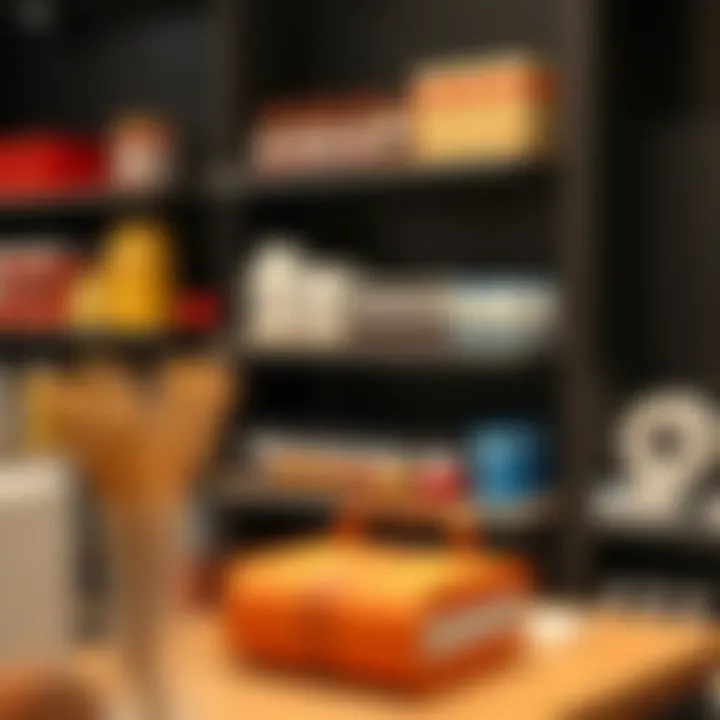
Conversely, closed shelving provides a sense of security and tidiness. Items can be neatly concealed behind doors or panels, which can aid in keeping products protected from dust or accidental mishaps. In a more premium setting, closed shelving can enhance perceived value. Investing in both types of shelving allows retailers to balance exposure and protection, catering to different product needs efficiently.
Considerations when choosing between open and closed shelving:
- Open Shelving:
- Closed Shelving:
- Pros: Enhances visibility, encourages interaction.
- Cons: May require more frequent organization and cleaning.
- Pros: Keeps items secure and presents a clean appearance.
- Cons: Limits access and visibility for potential buyers.
Wall-Mounted Displays
Wall-mounted displays are a game changer, especially for smaller retail spaces where every inch counts. Instead of relying solely on floor space, these shelves make good use of vertical areas, transforming walls into dynamic display areas. This method not only frees up room for customers to move but can also become a focal point of the store's design.
Imagine walking into a boutique where beautifully curated items are showcased on elegant wall shelves, drawing your eyes and encouraging you to explore what’s on offer. They can be particularly effective for specialty items or seasonal displays, allowing for easy adjustments without the need for bulky furniture.
However, it's crucial to ensure that wall-mounted displays are secure and can handle the weight of displayed items, as this not only affects aesthetics but also safety. Some elements retailers might want to consider include:
- Weight-bearing capacity: Ensuring the wall can support the shelving system.
- Aesthetic coherence: Aligning shelving styles with the overall theme of the shop.
In summary, the types of shop shelves you choose can profoundly impact the shopping experience and operational efficiency. Fixed versus adjustable, open versus closed, and wall-mounted options each serve specific needs and can be leveraged to enhance both display and functionality.
Materials for Shop Shelves
When it comes to shop shelves, the material used is not just a matter of preference but plays a significant role in functionality, aesthetics, and longevity. The right choice can enhance the overall shopping experience while meeting practical needs. Each material has its unique characteristics, benefits, and considerations that can influence design decisions. Knowing how to select and utilize various materials opens the door to creative and innovative shelving solutions that can positively affect retail environments.
Wooden Shelves and Their Versatility
Wooden shelves carry a charm that many find appealing. They can bring warmth and a touch of nature into a retail space, making products appear more inviting. The versatility of wood is notable, offering a range from oak to pine, each with its own color and grain. This variety allows retailers to choose styles that suit their branding and thematic displays.
- Benefits of wooden shelves include:
- Aesthetic Appeal: They can blend seamlessly with different decor.
- Strength: High-quality wood can support considerable weight, holding heavy products without bowing.
- Customization: Wooden shelves can be easily painted, stained, or carved for unique designs that mirror the store’s philosophy.
However, there are things to keep in mind. Wood can be susceptible to moisture, so in environments like florists or bakeries, it might require treatment or careful maintenance to avoid warping or damage.
Metal Shelving: Durability and Style
Metal shelving systems are often favored for their durability and sleek profiles. Stores looking to cultivate a modern or industrial vibe often lean towards metal components. This material withstands the test of time and use, showing little wear even in bustling retail environments.
- Key features of metal shelving include:
- Strength and Sturdiness: Metal shelves can typically hold more weight than their wooden counterparts, making them optimal for heavy inventory.
- Low Maintenance: They require little care and are often resistant to stains and spills which can be crucial in high-traffic areas.
- Design Flexibility: Occasional finishes like powder coating offer visual options, diversifying their appearance while remaining highly functional.
But one must be cautious. Metallic surfaces can get cold or unwelcoming, if not styled with care. Incorporating elements like wood or soft fabrics can balance the starkness, making the space more inviting for customers.
Glass Shelving for a Modern Touch
Glass shelves introduce a contemporary flair to retail spaces. They create a sense of openness and can make a small store appear larger. The transparency of glass allows products to shine while maintaining a sleek look.
- Advantages of glass shelving include:
- Illusion of Space: Perfect for smaller areas, as they don't obstruct sight lines.
- Showcase Products: Ideal for showcasing items like jewelry or high-end products where visibility adds appeal.
- Easy Integration: Glass can complement other materials beautifully, fitting seamlessly into varied designs.
Yet, glass does have its challenges, chiefly its fragility. While tempered glass can provide extra durability, care must be taken to avoid scratches and ensure its stability, especially in high-traffic areas.
Choosing the right material for shelving can significantly impact your shop's appeal and functionality. Each material offers unique benefits tailored to different styles and needs.
Incorporating such materials not only enhances the practicality of storage but also elevates the artistic presentation of products in retail environments. As retailers explore options, understanding the properties of these materials becomes essential in crafting impactful shopping spaces.
Designing Shelving Layouts
Creating effective shelving layouts is crucial in enhancing retail space. The layout not only influences the aesthetics of the shop but also significantly impacts customer behavior and sales. Thoughtfully designed layouts can maximize space, direct customer flow, and even highlight specific products. A well-structured shelve arrangement caters to both functionality and visual appeal, which are essential for a successful retail environment.
Grid Layouts for Optimal Space Use
Grid layouts are a popular choice for many retail environments, particularly in environments where space is tight. This structured approach involves aligning shelves in a grid-like pattern, utilizing vertical and horizontal lines to create clear pathways for customers. The simplicity of a grid layout enhances the shopping experience, allowing customers to navigate effortlessly.
The benefits of grid layouts include:
- Maximized Use of Space: With a precise allocation of space, retailers can insert more shelves without overcrowding. This results in increased product visibility.
- Easy Navigation: Customers can find what they’re looking for quickly, as the layout offers a straightforward route through the store.
- Encouraged Exploration: When organized well, the grid layout invites customers to discover additional products as they navigate through different sections.
However, careful consideration should be made when designing this type of layout. The design must consider the flow of customer traffic and where to place high-demand or promotional items for maximum exposure. Mixing in high and low shelving can also help break the monotony and add visual interest.
Creating Focal Points with Shelves
Strategically placed focal points can transform the shopping experience. By utilizing shelves to create visual anchors, retailers can draw attention to certain products, encouraging impulse buys and enhancing overall engagement. Focal points can be achieved by varying shelf heights, using unique shelf designs, or spotlighting trending items or specials.
To create effective focal points, consider the following strategies:
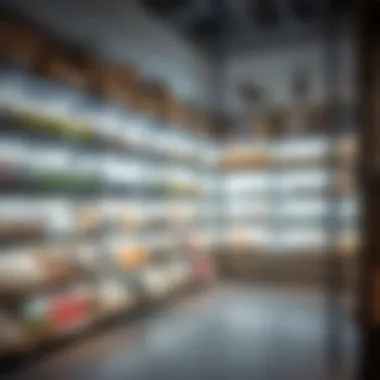
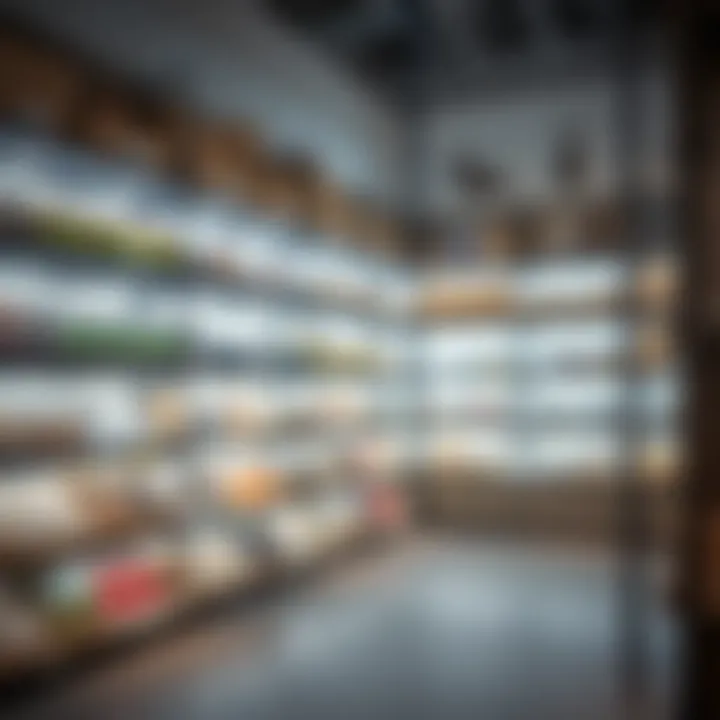
- Use Bold Colors: Splashing colors on shelving or the products displayed can catch customers’ eyes. A pop of color against a neutral background often draws attention.
- Display Best-Sellers at Eye Level: Items that are frequently purchased should be easily accessible. Placing them at eye level makes them more noticeable, enticing shoppers to engage with those products first.
- Incorporate Lighting Techniques: Lighting can greatly influence how products are perceived. Spotlights directed at focal shelves can create a dramatic effect, making products appear more desirable.
"In retail, about 70% of purchasing decisions are made at the point of sale, making focal points a key element in shelf design."
Zoning: Organizing Products Logically
Zoning is an important concept in shelving design that focuses on grouping similar products together. This logical organization helps customers find what they need quickly while encouraging them to browse related items, effectively increasing potential sales. Each zone should serve a distinct purpose, whether it's seasonal merchandise, best-sellers, or clearance items.
Tips for effective zoning include:
- Thematic Grouping: Group items according to themes or uses. For example, in a home improvement store, organizing paint supplies in one section makes sense.
- Clearly Marked Zones: Signage can enhance the zoning concept. Clearly labeling different areas helps guide customers and reduces confusion.
- Flexible Configurations: Use adjustable shelving to adapt zones as inventory changes. This way, retailers can keep their displays fresh and relevant to seasonal trends.
A well-organized zone not only simplifies the shopping experience but also instills a sense of order in the store, enhancing customer satisfaction.
Incorporating Lighting in Shelves
Lighting plays a crucial role in transforming the visual impact of retail displays. It’s not merely a practical necessity; it’s an art form that elevates the shopping experience. By integrating appropriate lighting solutions into shelving units, retailers can highlight products, create inviting atmospheres, and even influence customer purchasing decisions. The right kind of illumination can underscore the day-to-day beauty of merchandise, making it more enticing for the customers that wander through the aisles.
Incorporating lighting into shelves requires careful consideration of different elements that can enhance both display and functionality. The benefits of well-designed lighting setups are multi-faceted. For example, lighting can dramatically alter how colors and textures are perceived. A well-placed spotlight on a display can create a dramatic effect, drawing customers’ eyes and encouraging engagement with the product.
Some key considerations for incorporating lighting include:
- Lighting Type: Different approaches to lighting—such as spotlights, LED strips, and ambient lighting—affect how products are perceived and interacted with.
- Target Audience: Certain demographics respond better to specific lighting styles. Understanding your customer profile can essentially inform your lighting choices.
- Seasonal Adjustments: Lighting can be adapted to reflect seasonal themes and promotions. For instance, warmer tones during holidays can create a more festive atmosphere.
These aspects should intertwine seamlessly with your overall shelf design. Let's delve deeper into the various types of lighting suitable for display shelves.
Types of Lighting for Display Shelves
There’s a world of illumination possibilities that can breathe new life into your shelving units. Each type serves a distinct purpose and can dramatically change the customer’s experience:
- Spotlights: These are powerful tools for directing attention to specific items. Whether highlighting a brand's latest offering or a seasonal best-seller, spotlights can turn ordinary shelf space into a focal point.
- LED Strip Lights: Versatile and flexible, LED strips can be affixed under shelves for a soft glow that enhances product visibility. They work well for both aesthetic appeal and as functional lighting, guiding customers through product arrangements.
- Track Lighting: Ideal for larger displays, track lighting allows for adjustable beams that can be repositioned based on inventory changes. This adaptability is essential for businesses with a constantly shifting product array.
- Recessed Lighting: Offering a minimalist approach, recessed lights integrated into the shelf can provide subtle ambient warmth. They are less intrusive and can create a clean and modern look.
Creating Ambiance with Lighting
Once the right type of lighting is chosen, the next step is to consider how these fixtures contribute to the overall ambiance of the retail space. A harmonious blend of illumination can significantly impact shoppers’ emotional responses.
- Warm vs. Cool Lighting: Choosing a warmer light can evoke feelings of comfort and nostalgia, while cooler tones can convey a modern and sleek appearance. For instance, a home goods store may benefit from warm lighting, creating a cozy atmosphere, whereas an electronics store might utilize cool lighting to signal innovation and technology.
- Layered Lighting: This involves using multiple sources of light at different intensities to create depth and texture in displays. Layering can heighten visual interest and engage consumers more effectively. Combining ambient, task, and accent lighting achieves a three-dimensional effect that captivates.
- Mood Setting: Different products might require different atmospheres. For luxurious items, soft, dim lighting can create a sense of exclusivity, whereas bright, vibrant lighting may be more appropriate for children’s toys or summer fashion displays.
"Lighting is not just a consumer utility; it is a language that communicates emotions, shapes, and desires."
In sum, incorporating effective lighting into retail shelves can transcend functional requirements and set the stage for an unforgettable shopping journey. It works on many levels: enhancing visibility, creating a desired ambiance, and nurturing customer engagement. Well-thought-out lighting solutions not only illuminate products but also sculpt the very experience of shopping itself.
Seasonal Changes and Shelf Adaptation
Adapting shop shelves to seasonal changes is not just about aesthetics; it’s a crucial part of maintaining relevance and appealing to customers throughout the year. Different seasons bring various holidays and events, which retailers can leverage to attract shoppers through effective shelf design. When stores adjust their displays, they tap into the natural flow of consumer behavior, drawing in customers with fresh feels that align with current trends or festivities.
Refreshing Displays for Seasonal Promotions
Refreshing displays for seasonal promotions is like giving a new coat of paint to a well-loved room. It keeps things exciting for regular customers and invites curiosity from newcomers. These displays should not only showcase products but tell a story related to the season.
For instance, during the fall, a retailer might highlight warm colors, cozy apparel, and seasonal flavors like pumpkin spice. Incorporating elements such as small decorative pumpkins or autumn leaves can deepen the thematic representation. Such displays create an atmosphere that encourages purchase decisions.
- Key Aspects for Seasonal Refreshes
- Thematic Products: Choose items that are popular during the season.
- Strategic Placement: Position seasonal items at eye level to catch attention.
- Limited-Time Promotions: Offer discounts on seasonal items to boost sales.
Moving things around, arranging them in a way that reflects the season's vibe enhances the overall shopping experience. It’s not simply about mood but a well-planned strategy to maintain consumer interest and engagement.
Utilizing Seasonal Colors and Themes
The importance of color in retail cannot be overstated. Seasonal colors set the tone for the entire shopping experience. Different hues evoke various emotions and can encourage customers to explore more.
For instance, in winter, cooler colors such as blues and whites can create a serene atmosphere, evoking images of fresh snow and holidays. On the other hand, summer may call for bright, vibrant tones that exude energy and cheerfulness. By effectively utilizing these colors in shelving and overall store design, retailers can create a more immersive shopping environment.
Some practical tips for utilizing seasonal colors include:
- Incorporate Color Palettes: Choose a specific palette that reflects the season.
- Use Props and Accessories: Add items in seasonal colors around the shelves.
- Adjust Lighting: Colored lighting can enhance the seasonal effect greatly.
When these components come together seamlessly, they elevate the shopping experience. Wellsourced shelf displays echo the essence of each season, encouraging customers to spend more time in the space and engaging their senses, which is beneficial for sales.
"A well-designed shelf can evoke an experience that goes beyond mere buying; it's about feeling and connecting with the moment."
By paying attention to the details in seasonal changes and theme integration, retailers can ensure they remain dynamic and appealing year-round. This kind of thoughtful approach can ultimately lead to increased customer loyalty and sales.
Maximizing Small Spaces with Smart Shelf Solutions
When it comes to retail environments, the challenge of working with limited space can be daunting. Yet, the clever use of shelving can turn a cramped area into a visually pleasing and functional display that maximizes every square foot. Retailers often face the hurdle of needing to showcase a variety of products while not overwhelming their customers. Thus, smart shelf solutions can help strike the right balance between aesthetics and usability, essentially empowering retailers to transform smaller areas into attractive, engaging spaces.
Floating Shelves for Compact Areas
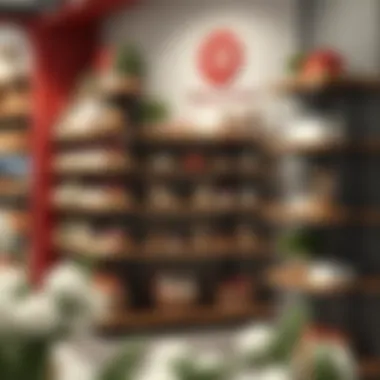

Floating shelves are a game changer in tight retail locations, providing a sleek and stylish solution without taking up valuable floor space. These shelves attach directly to the wall, creating the illusion of more room while allowing for creative displays.
- Versatility: Floating shelves come in various materials, like wood and metal, and can be customized in length or shape to fit unique wall spaces. This adaptability means they can easily accommodate different items – from glossy product boxes to decorative plants, theses shelves can showcase it all without feeling cluttered.
- Visual Lightness: One of the distinct advantages of floating shelves is that they provide a sense of openness. Not having bulky furniture or conventional units can make a shop feel airy, enhancing the overall shopping experience. They can be placed at different heights, guiding customers' eyes and drawing attention to specific merchandise.
- Supports Creativity: By using floating shelves, retailers can create levels in their displays, stacking products artistically. This approach provides an opportunity to tell a product story or represents a theme which captivates the attention of a passerby.
“Using floating shelves can lead to an explosion of creativity in merchandising, allowing products to be presented in ways that truly resonate with customers.”
Multi-functional Units: Combining Storage and Display
In smaller retail spaces, every piece of furniture must pull its weight, which is why multi-functional units have become a foundation for maximizing utility.
- Dual Purpose Display: A shelving unit that serves also as storage can be a lifesaver. For instance, a cabinet with a display top can hold extra stock behind closed doors while presenting bestselling items upfront. This duality not only saves space but keeps the area tidy.
- Adaptable Layouts: Furniture that can perform multiple tasks allows for flexibility. Retailers can rearrange their space easily by reconfiguring these units to suit different promotions or seasonal items. This ease of adjustment encourages fresh aesthetics and keeps customers intrigued, as they discover new displays every time they visit.
- Enhancing Customer Experience: When customers can see what is on offer without digging through drawers or boxes, it creates a smoother shopping journey. Units that combine storage and display not only showcase items effectively but also encourage impulse buys, as products are effortlessly accessible.
Incorporating these innovative shelving concepts into small retail spaces offers a practical yet stylish solution. Crafting an environment that celebrates creativity and functionality can significantly elevate the customer experience, allowing retailers to make the most of their limited square footage. With the right ideas, even the tiniest of shops can appear spacious and inviting.
Enhancing Customer Experience through Shelving
Creating a pleasing shopping experience begins long before the customer walks through the door. An often overlooked aspect is the role of shop shelving. Thoughtfully designed store shelves do more than just hold products; they serve as a silent salesperson, guiding customers and enriching their journey through carefully curated displays. The importance of maximizing customer engagement through shelving can’t be overstated. When shelves are arranged and designed thoughtfully, they resonate with shoppers, encouraging them to explore more and linger longer.
Encouraging Interaction with Strategic Placement
When it comes to shelf placement, intuition plays a big role. Shelves that invite interaction can pull customers deeper into the store, sparking curiosity and desirability. For instance, positioning products at eye level is not just about visibility; it caters directly to consumer psychology. Many shoppers are drawn to items that are immediately accessible, so placing high-demand items within reach can spark impulse buys. Likewise, end caps, or the shelves located at the ends of aisles, often serve as high-traffic areas that can feature seasonal or promotional items.
However, interaction takes on another dimension with engaging displays. Think about how specialty stores or boutiques use shelving to tell a story. Visual merchandising that highlights product pairings can encourage customers to envision how the items will work together in their own lives. Consider a home goods store showcasing utensils beside cookbooks. This nudges customers closer to the decision to purchase rather than simply browsing.
"A well-placed shelf is like a welcoming hand that beckons shoppers closer."
Access and Visibility: Key Factors in Shelf Design
Access and visibility are two paramount elements that affect customer experience. A tight space may lead to clutter, making it harder for customers to see what's available. Shelving designs that prioritize open spaces create a more inviting atmosphere. Avoid too many tightly packed items. Instead, consider gaps that allow a view into the entire display, ensuring shoppers can easily spot products that catch their interest.
In terms of visibility, transparency also plays a role. Clear shelving or well-lit sections can enhance the presentation of products, making them more appealing. Additionally, ensuring the shelves themselves are well-labeled can reduce frustration for browsers. Clear signage with prices and product information quickly informs shoppers, reducing the likelihood of them feeling lost or overwhelmed.
When customers can engage effortlessly with products and are met with a seamless flow throughout the store, it forms a sense of trust in the brand, inspiring loyalty and enticing them to return. A simple yet effective strategy is to utilize modular shelving systems, which can be rearranged as necessary to maintain a fresh look, responding to inventory changes and customer preferences.
Sustainable Options for Retail Shelving
In today’s retail landscape, sustainability has moved from being an afterthought to a central consideration for many business owners. It’s not merely about keeping up with market trends; it’s about fostering a responsible approach that appeals to environmentally conscious consumers. Retail shelves, often taking center stage in a shopping environment, offer an ideal opportunity to incorporate sustainable strategies. Whether it’s through the selection of materials or the methods of repurposing existing structures, the options available can enhance both display aesthetics and environmental responsibility.
Eco-Friendly Materials for Shelving
When it comes to shelving, the raw materials selected play a substantial role in the eco-friendliness of the overall design. Wood, particularly sourced from responsibly managed forests, stands out as a classic choice. Reclaimed wood, in particular, adds a rustic touch while reducing the need for new materials.
Metal options, like recycled aluminum or steel, are not only stylish but they also boast a lifecycle that can condense down the need for virgin resources. These metals are often produced with less energy input and can be recycled endlessly, minimizing waste.
Plastic shelves also have made strides toward sustainability. Look for products made from post-consumer recycled plastics, which can be quite durable while offering that eco-friendly label. By engaging in these options, retailers can align their values with those of their community, fostering loyalty and trust among consumers.
Some sustainable material options include:
- Reclaimed Wood: Adds charm and history; reduces waste.
- Bamboo: A rapidly renewable resource known for its strength.
- Recycled Metals: Durable and endlessly recyclable.
- Recycled Plastics: Lightweight and can be highly versatile.
Recycling and Repurposing Old Shelves
Replacing old shelves might seem like a straightforward path to keeping your store updated, but this mindset neglects a valuable opportunity for sustainability. Rather than sending old shelves to a landfill, consider recycling or repurposing them. This not only extends their life but also embraces resourcefulness.
Old wooden shelves can be refinished or painted for a fresh look. They can also be cut down to create smaller units or unique display features in other spaces. Similarly, metal shelves can often be re-coated or used in different configurations, adapting them to the evolving needs of retail environments.
By viewing shelving through a lens of flexibility and creativity, retailers can significantly reduce waste and costs associated with new materials. Furthermore, the narratives created around recycled and upcycled products can provide a powerful marketing edge, capturing the attention of consumers who prioritize sustainability in their purchasing decisions.
"Adopting sustainable shelving solutions not only benefits the environment but also elevates the ethical standards of retail businesses, showcasing a commitment to responsible practices."
Shopping experiences enriched with sustainable shelving options resonate with customers, further deepening their connection with a brand that prioritizes eco-friendliness. Implementing these innovative concepts makes a compelling case for leaving a positive footprint in the marketplace.
The Future of Retail Shelving
As consumer behavior continuously evolves, so must the environments where products are showcased. Discussing the future of retail shelving is key to understanding both emerging trends and innovative practices that can revitalize shopping experiences. Shoppers today seek more than just products; they desire experiences that resonate with their values and lifestyle. This necessitates a fresh approach to shelving that marries function with a strong sense of aesthetics.
Technological Innovations in Shelving
The impact of technology on retail shelving cannot be overstated. Modern advancements are helping retailers not just display goods but also interact in real-time with consumers. Smart shelving systems now embrace tools like digital price tags, integrated sensors, and connection capabilities with mobile apps.
- Digital price tags allow immediate updates, ensuring pricing reflects current promotions or stock levels.
- Weight sensors can monitor stock volume, alerting staff when items need restocking without constant manual checks.
- Integration with e-commerce platforms enables the seamless collection of data on customer preferences, allowing stores to tailor their displays dynamically.
With tech in the mix, retailers can create an environment that responds to the shopping rhythm, instantly altering displays based on current demand or seasonal trends. Retailers who embrace these technologies often find themselves ahead of the curve in satisfying customer needs, enhancing operational efficiencies, and ultimately driving sales.
The Rise of Modular Shelving Systems
Modular shelving systems represent a significant shift in design thinking, offering flexibility that traditional shelving lacks. These systems can be easily assembled, reconfigured, and expanded, satisfying the diverse needs of modern retailers. In a world where pop-up shops and temporary displays have become increasingly common, the ability to customize shelving arrangements is invaluable.
- Adaptability: Retailers can modify their shelf layouts to fit different product types or promotions without incurring hefty costs.
- Compactness: Modular designs often allow for space-saving solutions, making them suitable for both large and small retail environments.
- Aesthetic Versatility: By choosing different materials and finishes, retailers can craft a distinct look that aligns with brand identity.
Here’s how modular systems are changing the game:
- Easier Investment: Retailers can start with a small system and expand as needed, spreading out costs without sacrificing functionality.
- Sustainability: Many modular systems are made from recyclable materials, catering to the growing consumer demand for eco-friendly options.
- Enhancing Customer Experience: A visually appealing, easy-to-navigate store encourages prolonged customer interaction and enhanced sales potential.
The future of retail shelving is not just about holding products; it's about creating environments that build connections between shoppers and brands.
In summary, exploring the future of retail shelving reveals a landscape rich with potential. Technological innovations and modular designs redefine how products are showcased and set the stage for a more interactive and customer-centric shopping experience. Retailers who see these changes as opportunities rather than challenges are those likely to flourish in a competitive market.
